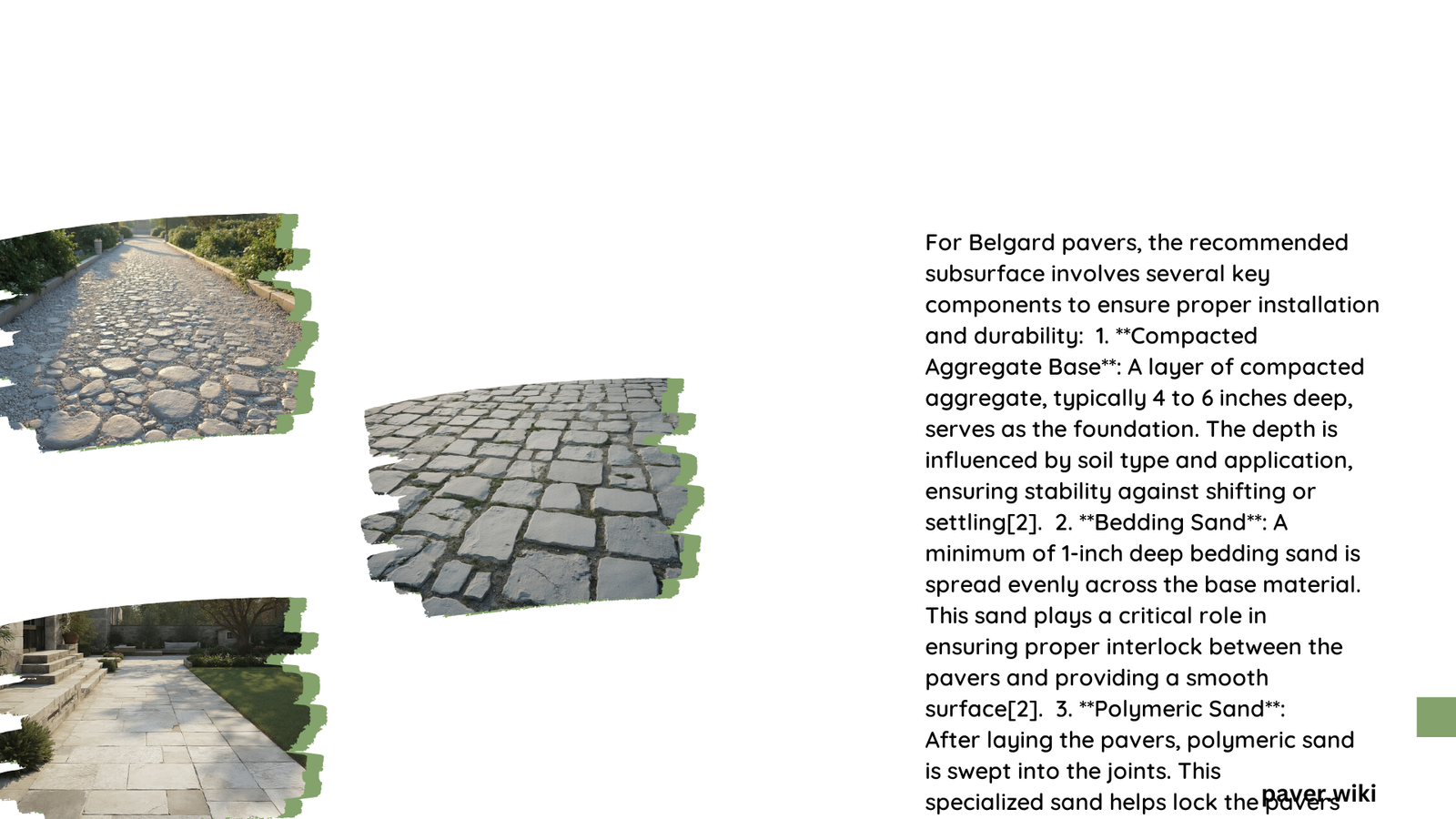The subsurface for Belgard pavers is crucial for a stable and long-lasting installation. It typically consists of an aggregate base layer, a bedding sand layer, and sometimes a geotextile underlayment. The aggregate base provides stability and drainage, while the sand layer ensures a smooth surface for paver placement. Proper preparation of these layers is essential for the durability and appearance of your Belgard paver project.
What Are the Key Components of a Belgard Paver Subsurface?
The subsurface for Belgard pavers comprises several important layers:
- Aggregate Base Layer
- Bedding Sand Layer
- Geotextile Underlayment (in certain conditions)
Aggregate Base Layer
- Consists of crushed gravel (3/4\” to dust)
- Provides stability and drainage
- Depth:
- 4-6\” for walkways and patios
- 8-12\” for driveways
Bedding Sand Layer
- 1\” thick layer on top of aggregate
- Helps in leveling and provides a smooth surface
- Some contractors may use screenings instead of sand
Geotextile Underlayment
- Recommended for heavy clay subsoil or rainy climates
- Prevents aggregate mixing with soil
- Ensures stability and prevents water accumulation
What Are the Different Paver Base Material Types?

Dry Mudset
- Used for overlaying existing concrete slabs
- Installs like sand, fills cracks and seams
- Hardens when water is applied
- Recommended thickness: 1/4\” to 1/2\”
Sand
- Preferred bedding material when not using dry mudset
- Requires edging restraint to prevent paver shifting
What Are the Installation Depth Requirements?
The total excavation depth includes:
- Paver thickness
- 1\” of bedding sand
- Aggregate base layer
Example calculation:
– For a 2-3/8\” (60mm) thick paver:
– Paver thickness: 2-3/8\”
– Bedding sand: 1\”
– Aggregate base: 4-6\” (walkways/patios) or 8-12\” (driveways)
– Total depth: 7-3/8\” to 9-3/8\” (walkways/patios) or 11-3/8\” to 15-3/8\” (driveways)
What Are the Drainage Requirements for Belgard Pavers?
Slope
- Minimum slope: 1 to 1.5 inches per 10 feet
- Ensures proper water drainage
- Should be achieved in the subsoil beneath pavers
Drainage Materials
- Geotextile Underlayment
- Prevents aggregate mixing with soil
-
Ensures proper drainage
-
Aggregate Base Layer
- Allows water to drain through gravel
Installation Techniques
- Compact subsoil and aggregate base using a large walk-behind compactor
- Ensure correct slope in subsoil to prevent water accumulation
How to Prepare the Sub-Base for Belgard Pavers?
Compaction Methods
- Compact subsoil before adding aggregate base layer
- Use a large walk-behind compactor for:
- Aggregate base layer
- Bedding sand layer
Common Challenges and Solutions
| Challenge | Solution |
|---|---|
| Uneven Base | Level base rock within 1/4-3/8\” tolerance |
| Heavy Clay Soil | Use geotextile underlayment to prevent aggregate mixing |
What Are the Best Practices for Belgard Paver Subsurface Installation?
- Ensure proper excavation depth based on paver thickness and intended use
- Use high-quality aggregate base material
- Compact each layer thoroughly
- Maintain correct slope for drainage
- Use geotextile underlayment in challenging soil conditions
- Apply bedding sand or dry mudset evenly
- Install edge restraints to prevent paver shifting
By following these guidelines, you can create a stable and long-lasting subsurface for your Belgard paver project, ensuring beautiful results that will stand the test of time.
References:
1. https://www.belgard.com/blog/2012/10/11/laying-pavers-over-concrete/
2. https://www.belgard.com/blog/2017/07/18/installing-proper-base-concrete-porcelain-paver-projects/
3. https://paveroutlet.com/belgard-dimensions-pavers
